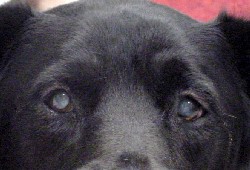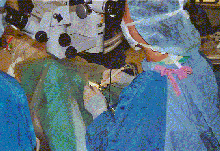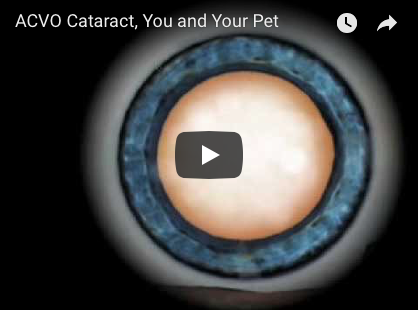Cataracts
What is a cataract?
A cataract is an opacity of the lens. The lens normally focuses light onto the back of the eye and allows animals to focus. Cataracts typically affect vision and may be very small or involve the entire lens causing blindness.
Older animals often develop increased density to their lens called nuclear sclerosis. This typically causes the eyes to look cloudy but does not affect vision significantly (these animals simply need "reading glasses").
What causes cataracts?
Cataracts in dogs are most commonly inherited or the result of diabetes mellitus. Cataracts can also be caused by uveitis (internal eye inflammation), severe trauma, or inherited retinal diseases like Progressive Retinal Atrophy. Canine cataracts are frequently seen in all age groups, including young dogs. The genetics of cataracts is complex and we are still finding out exactly how it is inherited.
Cataracts in cats and horses are most commonly the result of uveitis (internal eye inflammation, moon blindness). We do rarely see inherited cataracts in these species as well. Other species also develop cataracts and the reasons vary with the species and the individual.
How can cataracts be treated?
No medical treatment has been proven to prevent or eliminate cataracts. Cataracts can be removed with surgery, just as in people. The technology to remove cataracts in animals is the same in animals as in people. We use ultrasound or phacoemulsification to break up the cataract and remove it. The equipment at Veterinary Eye Centers PLLC is the same quality and standard as for human cataract surgery.
In cataract surgery, an incision is made in the clear cornea. An incision is also made in the lens capsule, a clear bag that contains the lens and cataract. Phacoemulsification or ultrasound is used to break up the cataract while removing the fragments at the same time. The lens capsule typically remains in the eye and a small controlled hole is made in the front of the capsule. The lens capsule is attached to many other structures in the eye so surgical success is higher when it is not disrupted. After lens removal, we have the option of placing a replacement lens for dogs and cats. Small sutures are placed in the cornea after surgery.
Cataract surgery is done under general anesthesia in animals. The entire procedure is performed using an operating microscope. In humans, cataracts are removed one at a time but we prefer to remove both cataracts under one anesthetic episode to minimize the anesthesia risks in animals. We have found no difference in the outcome for dogs and cats when both eyes are done at the same time.
Laser surgery is occasionally used after cataract surgery to polish the final result but is not used to remove cataracts in people or animals.
 How is vision affected by removing the lens? How is vision affected by removing the lens?
The lens focuses objects that are about 2 to 4 feet and closer. Animals without a lens replacement will have very blurry vision in this near range. Dogs and cats actually have a more grainy vision than people, and their near vision is also worse, even with a normal lens.
Animals with a lens replacement will have normal near vision and see better sooner. Lens replacements can, however, also act as a foreign body in the eye and perpetuate uveitis (internal eye inflammation) in some individuals. We will discuss each animals risk for this at the initial appointment.
After cataract surgery, animals will have good far distance vision whether they have a lens replacement or not.
How successful is cataract surgery? Can vision always be restored?
Cataract surgery in dogs is typically 90% successful at improving or restoring vision. One in ten dogs do not have improved vision because of complications that include uveitis (internal eye inflammation), glaucoma (high pressure in the eye) or retinal detachment.
Some animals are not good candidates for cataract surgery because they have other eye diseases that are causing blindness as well in addition to the lens. Retinal diseases can cause blindness and cataracts. If cataracts are removed in an animal with retinal disease, vision won't be restored. We screen animals for retinal disease before surgery with an ultrasound of the eye (for retinal detachments) and an electroretinogram (quantitative test of retinal function).
When is the best time to do cataract surgery?
Cataracts are best removed when vision impairment is present, but before the lens has matured too much.
Animals with active eye inflammation need to be medically treated to control the inflammation before surgery. The presence of a cataract alone can cause uveitis (internal eye inflammation). The lens is made of material that is not typically exposed to the immune system. When the lens leaks proteins, the immune system can start to react to the presence of the lens material. Lenses that are too old (hypermature) have a lower success rate than "younger" lenses. Let us examine your pet as soon as cataracts are diagnosed to determine the best timing for surgery.
Other eye diseases like glaucoma (high pressure in the eye) or uveitis for another reason may limit or prevent treatment for the cataracts.
What are the complications of cataract surgery?
Complications include chronic uveitis (internal eye inflammation), glaucoma (high eye pressure), retinal detachment and infection. Diabetic dogs are at an increased risk for some of these complications.
Cataract surgery is done through an operating microscope under general anesthesia. As with any other surgery, anesthesia carries inherent risks. We do a physical exam and blood tests +/- urinalysis before surgery to evaluate your pet's overall health. If any health problems are found, we will address them before surgery. In dogs with diabetes mellitus, they must be very well regulated with insulin and food before anesthesia and surgery so that their regulation is not disrupted.
We take general anesthesia very seriously and have advanced anesthesia monitoring including blood pressure, exhaled carbon diode, oxygen content, heart rate, respiration rate, temperature and EKG for heart arrythmias. Each animal is monitored continuously throughout anesthesia by a veterinary technician anesthetist. We use armored endotracheal tubes to protect the airway and use every means to minimize the risks of anesthesia.
Can a cataract regrow after surgical removal?
A dense cataract will not regrow in dogs or cats after surgical removal. A few animals can develop lens capsule deposits that might need laser treatment in the future. In young animals (less than 5 years old), the lens is still growing. In surgery, the majority of cells that make new lens material are removed. In very young animals (less than 1 year of age), a small amount of lens can regrow. This will typically not affect vision but can cause chronic uveitis (internal eye inflammation).
What treatment is needed in the recovery period after surgery?
The treatments after surgery are as important to the outcome as the surgery itself. Pets will need eye drops and oral medications following surgery to control inflammation and prevent infections of the eyes. The eyes will be carefully monitored by a veterinary ophthalmologist in recheck examinations. These recheck examinations are done at 1 week and then every 2-3 weeks after surgery for several visits. We are looking for any problems or complications from surgery, and medication dosages will be adjusted for each patient depending on how their eyes are healing after surgery. There are sutures finer than hair placed on the eye so the eyes are very delicate until the incisions heal. Animals need to wear an E (Elizabethan) collar at all times until their incisions have healed. Written discharge instructions with "signs to watch for" are discussed and provided to the owners for each pet after surgery. We want to work as a team with owners to provide the best communication and care for their animals after cataract surgery. Animals that have had cataract surgery are examined annually.
What else should I know about cataract surgery?

Video created by the American College of Veterinary Ophthalmologists
|